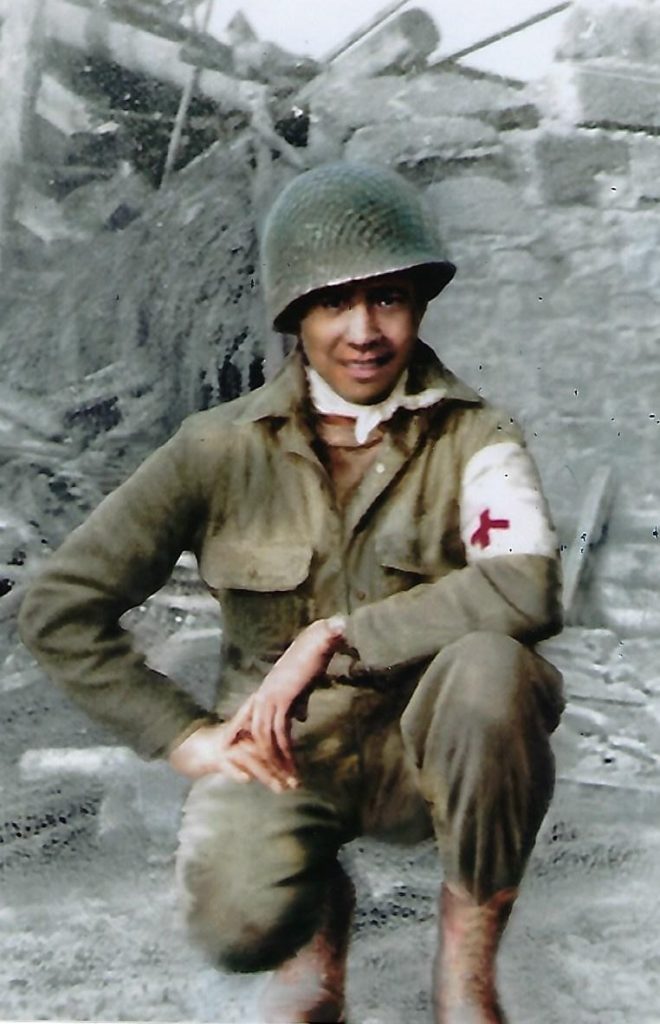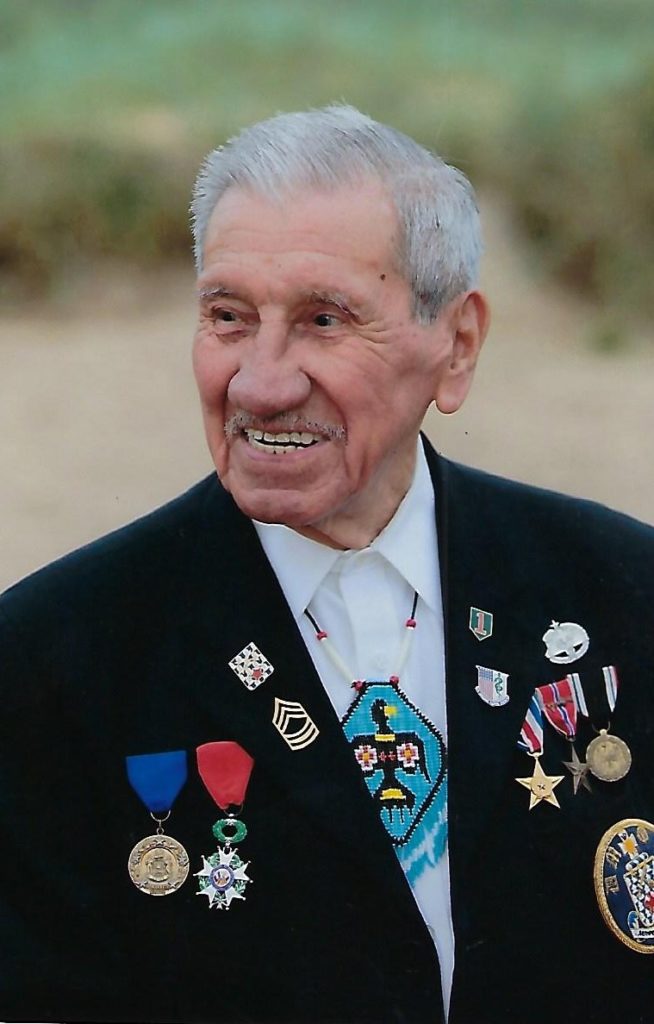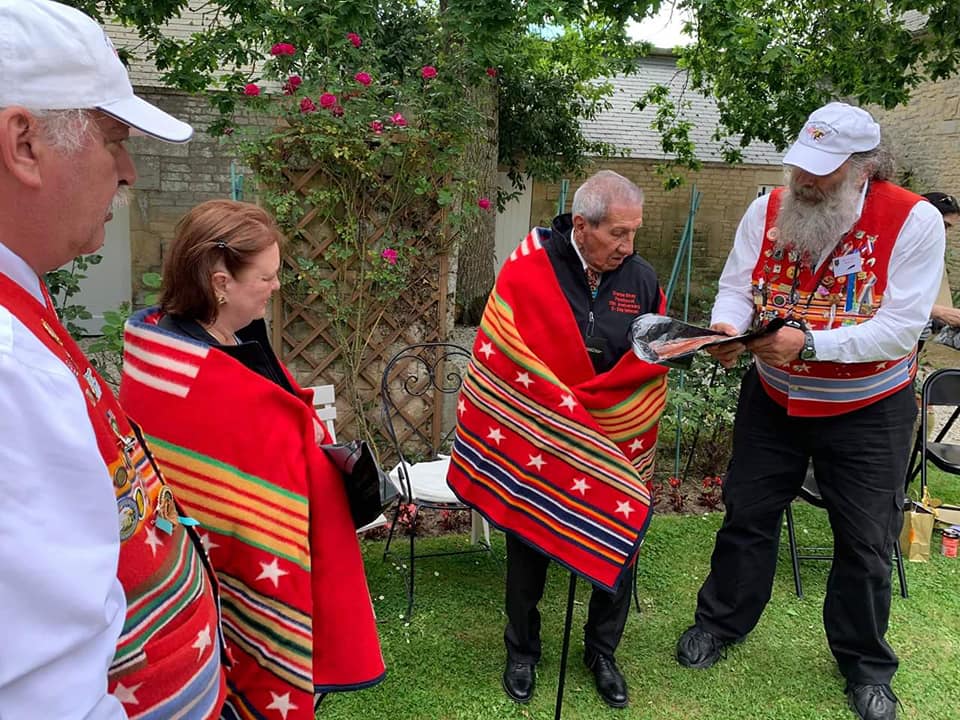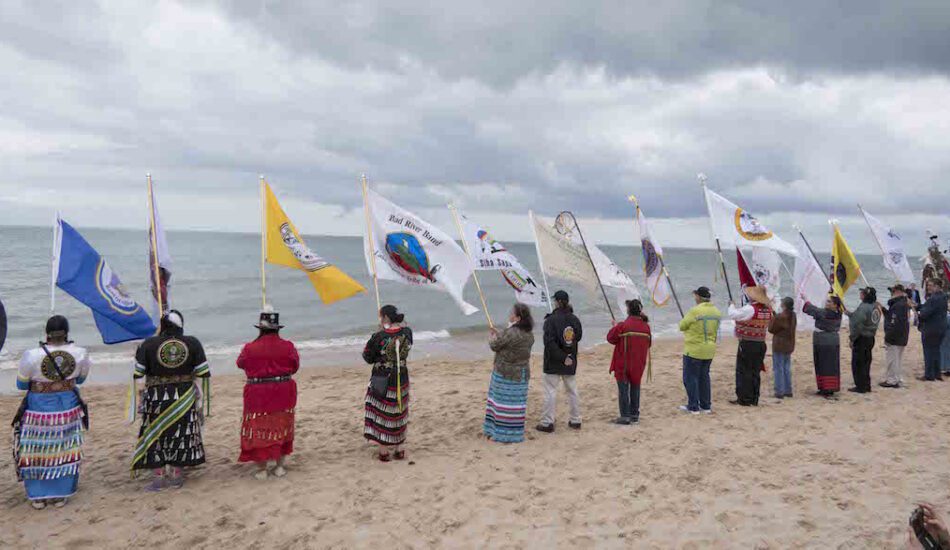By MICHAEL SISSON, Puyallup Tribal Veterans Representative
The Puyallup Tribal Veterans recently made a trip to Normandy, France for nine days to participate in the 75th D-Day Anniversary Celebrations; we were invited by Joe Podlasek, CEO of Trickster Gallery in Shaumberg, Illinois and by Madame Marie-Pascale Legrand to participate along with Tribal Veterans from several other Tribes to be part of the “Charles Norman Shay Delegation”. Charles Shay is a Penobscot Tribal Elder, writer and decorated veteran of both World War II and the Korean War. Along with a Bronze Star and Silver Star, Shay was also awarded the Legion d’Honneur, making him the first Indian in Maine with the distinction of French chevalier.
Charles Shay was drafted into the military in 1943 at the age of 19. He was selected for training as a medical technician and learned basic surgery skills. Shay joined the Medical Detachment of the first Division’s (the “Big Red One”) 16th Infantry Regiment and was attached as a platoon medic to Fox Company. As a combat medic, Shay treated as many of his wounded comrades as possible – bandaging wounds, applying tourniquets, applying makeshift splints, administering morphine and otherwise trying to make the wounded as comfortable as possible. Shay pulled several struggling soldiers from the rising tide, saving many immobilized wounded from drowning during the first wave of the landing of Omaha Beach on D-Day. He was also present helping the fallen at the Battles of Aachen, Huertgen Forest, and the Ardennes (Battle of the Bulge).
Charles Shay was later attached to a reconnaissance squadron moving into the small farming village of Auelnear the Sieg River in Germany. The squadron encountered about 20 German soldiers accompanied by a Panzer tank with an 88mm weapon, and were forced to surrender. The squadron was then marched 50 to 60 miles, moving only by night, to the POW camp Stalag VI-G. The column of prisoners grew along the way as the German unit accumulated more and more American soldiers. Shay was interrogated at the camp and held there until April 12, 1945 when American troops encircled the camp, trapping 350,000 enemy soldiers and liberating the camp. Shay was sent home soon after.
The day after we arrived in France we went to Madame Legrande’s home to meet the rest of the Charles Shay Delegation, to exchange gifts and for lunch. Charles and Marie seemed very interested in the smoked salmon we gifted them (thank you Daryle Barnes). It was refreshing to see so many Tribal Veterans we knew from our previous trips to Menominee Powwows and the National Gathering of American Indian Veterans. We all had a good time reminiscing with each other.
After that we went to Château de Colombières where the Delegation was greeted by the Count and Countess de Maupeou D’Ableiges. This Castle was the place where the US Army placed a propaganda site where they created and printed document and flyers and then sent them to the German troops behind their lines. The drawings were created by Hollywood designers, then printed in the basement of the castle, inserted into shells by French women and finally dropped above German troops. Interestingly enough, around July 14, 1944, Charles Shay’s company spent a week in the fields surrounding the castle.
Then we went to Utah Beach where Dr. Paul H. Herbert held a historical conference about the events leading up to the invasion of Utah Beach were highlighted. It was extremely interesting because you could look right out at the beach and see exactly what he was discussing.
The next morning we went to an Educational Meeting at Trévières School. The Charles Shay Delegation was welcomed by children, teachers and the Director of the School. This was an opportunity for the French Children to meet a World War II Veteran and also learn about Native American soldiers and Native American cultural aspects. The children had several gifts and questions for Charles Shay. Afterwards the school provided the Delegation with lunch.
We then left for the Normandy US War Cemetery where we had a small ceremony where we posted our Eagle Staffs and Tribal Flags and then we went through the cemetery placing pictures of the soldier, a rose, some tobacco, burnt some sage, sang a song and brushed off the headstones with an Eagle feather at the headstones of 29 known Native American soldiers who are laid to rest there.
Following the paying of respects for our fellow Tribal Veterans we attended another historical conference, once again led by Dr. Paul H. Herbert, where he discussed the Red sector of Omaha Beach which is the exact place that Pvt Charles Shay landed with the first wave at 6:30 am on D-Day while under intense fire coming from a machine gun MG 42 used by German soldier Heinrich Severloh. Charles treated the wounded until he was exhausted at mid afternoon. Around 11:00 a.m. he discovered a fellow comrade, Pvt Edward Morozewicz, who was also a medic. Eddie was deeply wounded and Charles tried to save his life. He gave him a shot of morphine to relieve his pain and stayed with him until Eddie passed away in his arms.
We then went to the 1st Infantry Division Monument just outside the Omaha Beach Cemetery. There we posted our Eagle Staffs and Tribal Flags for a Ceremony honoring members of the 1st Infantry Division by the Mayor of Colleville sur Mer. There was a special tribute to Pvt Edward Morozewicz and Frank Towers, followed by a tribute to Jewish soldiers, wreath laying, Bag Pipes and we all released balloons containing individual personalized messages in the name of soldiers, including the 38 Native American soldiers buried at U.S. Normandy and Brittany cemeteries.
The next morning we went to a ceremony to honor Airborne troops and flight crews in Picauville. The ceremony was held near the Memorial to the crews of the 9th U.S. Air Force, and paratroopers of the 82nd and 101st U.S. Airborne Divisions, who died in a crash of their planes in the sector of Picauville on June 6th and 7th, 1944.
We then went to the Brittany Cemetery where we participated in retiring the Colors for the day. The Delegation then posted our Eagle Staffs and Tribal Flags before heading out into the Cemetery to honor the 9 Native American Veterans buried there as we had done at the Normandy U.S. War Cemetery the day before.
The next morning we went to the Charles Shay Indian Memorial in Saint Laurent sur Mer. This was a very moving Ceremony east of Omaha Beach. We finally had an opportunity to stand where so many fell on that fateful morning, I remember I was overcome with emotion. There was a blessing ceremony, dancing by Jingle Dress dancers, speeches by a couple of Generals. We then went down to the beach for a water ceremony. Afterwards we did pictures on the beach of the Eagle Staffs and the Tribal flags all lined up.
Later that day we went to Sainte Mère Eglise to attend a dinner banquet hosted by les Amis des Vétérans Américains (Friends of American Veterans). It was quite a lavish meal in an old airplane hanger. We reunited with both Veterans and local French people we had met the previous days to enjoy a meal.
The following day we went to a Conference that discussed the role of Comanche Code Talkers in World War II. After that we prepared to come back home after nine days of learning how much we are appreciated in France.
“First of all, I would like to thank Tribal Council for this once in a lifetime experience. Each and every event that we attended had its own special meaning to me and I’m sure I was not the only one that felt this way. It was a true honor to be in the company of these veterans and to hear their stories. Even though we traveled many miles to attend these events it was all worth it. From the beauty of the country side to the battlefields where history was made. It was magnificent. The people of France made every effort to accommodate us where ever we went and made sure our stay was the best it could be. The most important thing of all was getting the chance to honor our fallen soldiers at their place of rest.”
– Tribal Veteran Clarence Tougaw
“As for me, I am overwhelmingly grateful to Tribal Council for allowing the Tribal Veterans to participate in this remembrance of history. Granted we can talk to our fellow Veterans and read the history books; but there is nothing more vivid than going to France, speaking with the local people, hearing their stories as you look at where what they are talking about actually happened. To hear the gratefulness of the French people when they speak to you, the passion in their voices only makes listening to them more meaningful. This trip was emotional as well. You feel pride, patriotism and pain all at once when you visit the American Cemeteries there. The one thing I remember most was when I was at the Normandy US War Cemetery; I was walking on the bluffs above where the landing was. The beach was long, the tide was coming in and I could see sand from the shallow beach stretching about a half a mile off of shore. I closed my eyes and I could imagine soldiers running to shore carrying their gear, getting shot by German machine gun fire. Then I turned a corner and saw all the white marble crosses of the gravesites; I was overcome with emotion and fell to my knees and wept briefly. I was honored to be there and I was honored to represent the Puyallup Tribe of Indians.”
– Tribal Veteran Rodeny Sisson








